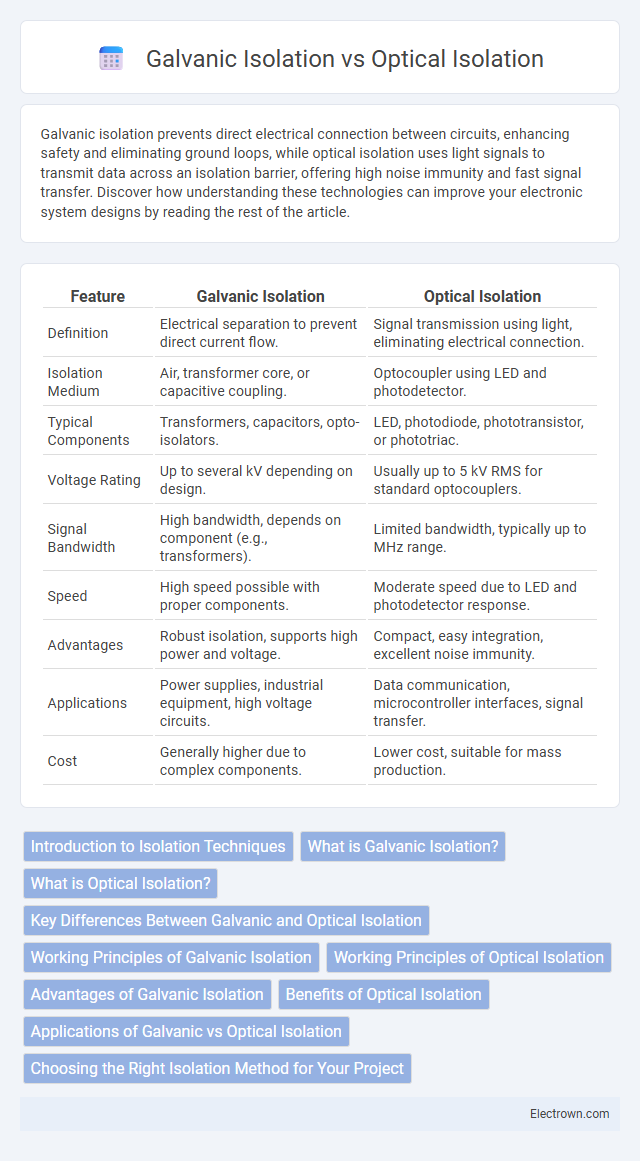Galvanic isolation prevents direct electrical connection between circuits, enhancing safety and eliminating ground loops, while optical isolation uses light signals to transmit data across an isolation barrier, offering high noise immunity and fast signal transfer. Discover how understanding these technologies can improve your electronic system designs by reading the rest of the article.
Table of Comparison
| Feature | Galvanic Isolation | Optical Isolation |
|---|---|---|
| Definition | Electrical separation to prevent direct current flow. | Signal transmission using light, eliminating electrical connection. |
| Isolation Medium | Air, transformer core, or capacitive coupling. | Optocoupler using LED and photodetector. |
| Typical Components | Transformers, capacitors, opto-isolators. | LED, photodiode, phototransistor, or phototriac. |
| Voltage Rating | Up to several kV depending on design. | Usually up to 5 kV RMS for standard optocouplers. |
| Signal Bandwidth | High bandwidth, depends on component (e.g., transformers). | Limited bandwidth, typically up to MHz range. |
| Speed | High speed possible with proper components. | Moderate speed due to LED and photodetector response. |
| Advantages | Robust isolation, supports high power and voltage. | Compact, easy integration, excellent noise immunity. |
| Applications | Power supplies, industrial equipment, high voltage circuits. | Data communication, microcontroller interfaces, signal transfer. |
| Cost | Generally higher due to complex components. | Lower cost, suitable for mass production. |
Introduction to Isolation Techniques
Galvanic isolation uses physical barriers such as transformers or capacitors to prevent direct electrical conduction, ensuring no current flows between circuits while allowing signal transfer. Optical isolation employs optocouplers that transmit signals via light, providing high-voltage isolation and immunity to electromagnetic interference. Your choice between these isolation techniques depends on factors like voltage levels, signal integrity, and application requirements.
What is Galvanic Isolation?
Galvanic isolation refers to the method of isolating functional sections of electrical systems to prevent current flow while allowing signal or power transfer. This isolation protects your equipment from high voltages and electrical noise, enhancing safety and system reliability. It is commonly achieved through transformers, optocouplers, or capacitive coupling, ensuring no direct electrical connection exists between isolated circuits.
What is Optical Isolation?
Optical isolation uses light to transmit signals between circuits, providing complete electrical separation and preventing high voltages from damaging sensitive components. It is commonly implemented with optocouplers, which convert electrical signals into light and then back into electrical signals on the receiving side, ensuring noise immunity and signal integrity. Optical isolation protects your equipment by blocking voltage spikes and reducing interference in communication systems.
Key Differences Between Galvanic and Optical Isolation
Galvanic isolation prevents direct electrical conduction between circuits using transformers, capacitors, or inductors to block current flow while allowing signal transfer. Optical isolation employs light signals transmitted through an optocoupler, ensuring complete electrical separation and immunity to high voltage spikes. Your choice depends on application requirements like voltage levels, signal integrity, and response speed.
Working Principles of Galvanic Isolation
Galvanic isolation works by preventing direct electrical connection between circuits, using transformers, optocouplers, or capacitive coupling to transfer signals or power while blocking DC current flow. This isolation ensures that high voltage spikes or noise from one circuit do not affect the other, enhancing safety and signal integrity. In contrast to optical isolation, which uses light signals to transmit data across an insulating barrier, galvanic isolation can employ magnetic or electric fields for effective separation.
Working Principles of Optical Isolation
Optical isolation operates by transmitting electrical signals through light pulses using an LED and a photodetector, creating a physical barrier that prevents direct electrical connection and ensures signal integrity. This method provides high-voltage isolation and noise immunity by converting electrical input into optical signals, which are immune to electromagnetic interference (EMI). Optical isolators are widely used in sensitive electronic circuits to protect against voltage spikes and ground loop currents.
Advantages of Galvanic Isolation
Galvanic isolation offers superior protection against electrical noise and voltage spikes by physically separating circuits without direct electrical connection, enhancing system safety and reliability. It improves signal integrity in sensitive equipment and prevents ground loops that can cause interference or damage. Your electronic systems benefit from increased durability and reduced risk of electrical faults, making galvanic isolation essential in high-voltage and industrial applications.
Benefits of Optical Isolation
Optical isolation provides superior noise immunity and enhanced signal integrity by using light to transfer signals, effectively eliminating electrical interference and ground loop issues. Its high-voltage isolation capability protects sensitive devices and improves overall system reliability, making it ideal for industrial and medical applications. By choosing optical isolation, you ensure safer and more reliable communication between different circuit sections.
Applications of Galvanic vs Optical Isolation
Galvanic isolation is commonly used in power supplies, transformers, and high-voltage equipment to prevent direct current flow while allowing signal transfer, ensuring safety and noise reduction in electrical systems. Optical isolation finds its primary applications in data communication, microcontroller interfaces, and medical devices, where signal integrity and immunity to electromagnetic interference are crucial. Your choice between galvanic and optical isolation depends on the specific requirements for voltage separation, signal type, and environmental conditions.
Choosing the Right Isolation Method for Your Project
Selecting between galvanic isolation and optical isolation depends on project requirements such as voltage levels, signal fidelity, and environmental conditions. Galvanic isolation offers superior protection against high voltage spikes and ground loops, making it ideal for power electronics and industrial applications. Optical isolation excels in high-speed data transmission and electromagnetic interference immunity, suitable for communication interfaces and sensitive signal processing tasks.
Galvanic Isolation vs Optical Isolation Infographic

 electrown.com
electrown.com